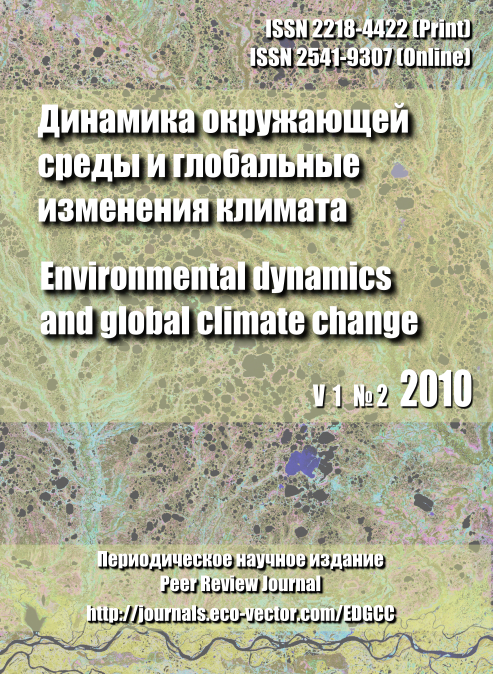Biological productivity of oligotrophic and eutrophic peatlands in southern taiga in Western Siberia
- Authors: Golovatskaya E.A.
- Issue: Vol 1, No 2 (2010)
- Pages: 6-
- Section: Articles
- Published: 15.06.2010
- URL: https://edgccjournal.org/EDGCC/article/view/6466
- DOI: https://doi.org/10.17816/edgcc126-
- ID: 6466
Cite item
Full Text
Abstract
The results of long-term (1999-2006) investigations of dynamics of vegetation storages, phytomass growth, dead matter, and net primary productivity (NPP) at oligotrophic and eutrophic peatlands in southern taiga in Western Siberia (Tomsk region) are presented. The storages of phytomass at different ecosystems of oligotrophic bog have similar values. Storages of phytomass at eutrophic peatland are 2 times higher in comparison to oligotrophic bog. The qualitative composition of phytomass depends on vegetation of the studied ecosystems, nutrient availability and hydrothermal conditions.
About the authors
Evgeniya Aleksandrovna Golovatskaya
Author for correspondence.
Email: golovatskaya@imces.ru
References
- Billings W.D., Luken J.O., Mortensen D.A., Peterson K.M. 1982. Arctic tundra: A source or sink for atmospheric carbon dioxide in a changing environment? // Ecologia. 53. P 7- 11.
- Birukova O.N., Orlov D.S. 1995. Stocks of carbon of organic compounds in soils of the Russian Federation. Eurasian Soil Sci. № 1. P..21-32.
- Botch M.S., Kobak K.I., Vinson T.S., Kolchugina T.P. 1995. Carbon pools and accumulation in peatlands of the former Sovet Union // Global Biogeochem Cycles. 9(1). P.37-46.
- Carroll P., Crill P. 1997. Carbon balance for a temperate poor fen // Global Biogeochem Cycles. 11(3). P.349-356.
- Cherepanov S.K. 1995. Vascular plants of Russia and adjacent states (the former USSR). Sankt-Peterburg. 990 p.
- Chramov A.A., Valutskii V.I. 1977. Forest and bog phytocenosis of East Vasuganiya.-Novosibirsk. Nauka. 219 p. (in Russian)
- Efremov S.P., Efremova T.T. 2007. Experimental diagnostics of peat accumulation and transformation of organic matter in bog-forest ecosystems of Western Siberia // West Siberian peatlands and Carbon Cycle Past and Present. Proc of the Second Int Field Symposium. P.95-97. (in Russian).
- Efremova T.T., Efremov S.P., Kosych N.P., Mironycheva-Tokareva N.P., Titlyanova A.A. 1994. Biological productivity and soils of bogs at south Vasuganiya // Siberian Journal of Ecology. 3. P.253-267 (in Russian).
- Efremov S.P., Efremova T.T., Melent'eva N.V. 1994. Carbon stocks in bog ecosystems // Carbon in ecosystems of forest and swamps of Russia. Edited by V.A. Alekseev and P.A.Berdsi - Krasnoyarsk, P. 128-139.(in Russian).
- Golovatskaya E.A., Porokhina E.V. 2005. Botany with Fundamental Phytocoenology. Biologic Productivity of Bog Biogeocoenoses: A Handbook. TGPU, Tomsk. 64p. (in Russian).
- Gorham E. 1991. Northern Peatlands: role in carbon cycle and probable responses to climatic warming // Ecol. Applic. 1(2). P.182-195.
- Ignatov M.S., Afonina O.M.1992. Check-list of mosses of the former USSR // Arctoa. Vol. 1 (1-2). P. 1-85.
- Kim J., Verma S.B. 1992. Soil surface CO2 flux in a Minnesota peatland // Biogeochem. 18. P.37-51.
- Klinger L.F., Zimmermann P.R., Greenberg J.P., Heidt L.E., Guenther A.B. 1994. Carbon trace gas fluxes along a successional gradient in the Hudson Bay Lowlands // J. Geophys. Res. 99. P.1469-1494.
- Moore T.R., Bubier J.L., Frolking S.E., Lafleur P.M., Roulet N.T. 2002. Plant biomass and production and CO2 exchange in an ombrotrophic bog // J. of Ecology. 90. P.25-36.
- Moore T.R., Knowles R. 1989. The influence of water table levels on methane and carbon dioxide emissions from peatland soils // Can. J. Soil Sci. 69. P.33-38.
- Neumann H.H., Hartog G., King K.M., Chipanshi A.C. 1994. Carbon dioxide flux over a raised open bog at the Kinosheo Lake tower site during the Northern Wetlands Study (NOWES) // J Geophys. Res. 99(D1). P.1529-1538.
- P'yavchenko N.I. 1967. On the productivity of bogs of Western Siberia // Rastitelnye resursy. 3(4). P. 523-532. (in Russian).
- Sheng Y., Smith L.C., MacDonald G.M., Kremenetski K.V., Frey K.E., Velichko A.A., Lee M., Beilman D.W. and Dubinin P. 2004. A high-resolution GIS-based inventory of the west Siberian peat carbon pool // Global Biogeochem. Cycles. 18: GB3004.
- Silvola J., Alm J., Ahlholm U., Nykanen H., Martikainen P.J. 1996. CO2 fluxes from peat in boreal mires under varying temperature and moisture conditions. J of Ecology 84:219-228.
- Szumigalski A.R., Bayley S.E. 1997. Net aboveground primary production along a peatland gradient in central Alberta in relation to environmental factors // Ecoscience. 4. P.385-393.
- The Great Vasyugan Bog. Current State and Evolution Processes. 2002. ed. by Kabanov MV, IOA SO RAN, Tomsk. 230 p. (in Russian).
- Titlyanova A.A.1988. Biological Productivity of Grass Ecosystems.Novosibirsk.Nauka. 131 p. (in Russian).
- Titlyanova A.A., Bulavko G.I., Kudryashova S.Ya., Naumov A.V., Smirnov V.V., Tanasienko A.A. 1998. Storages and losses of organic carbon in Siberian soils // Eurasian Soil Sci. 1.P.51-59. (in Russian).
- Valutskii V.I., Chramov A.A. 1976. Theory and practice of forest telmathology and forest reclamation, Krasnoyarsk. P.59-82. (in Russian).
- Vomperskii S.E. 1994. Peatlands role in the carbon cycle. Biogeocenotic features of peatlands and their rational use. Nauka, Moscow. P.5-73.(in Russian).
- Vomperskii S.E.. Cyganova O.P., Kovalev A.G., Gluchova T.V., Valyaeva N.A. 1999. Waterlogged of territory of Russia as the factor of fixing of atmospheric carbon. Carbon cycle in territory of Russia. Moskow. P.124-146.
Supplementary files










